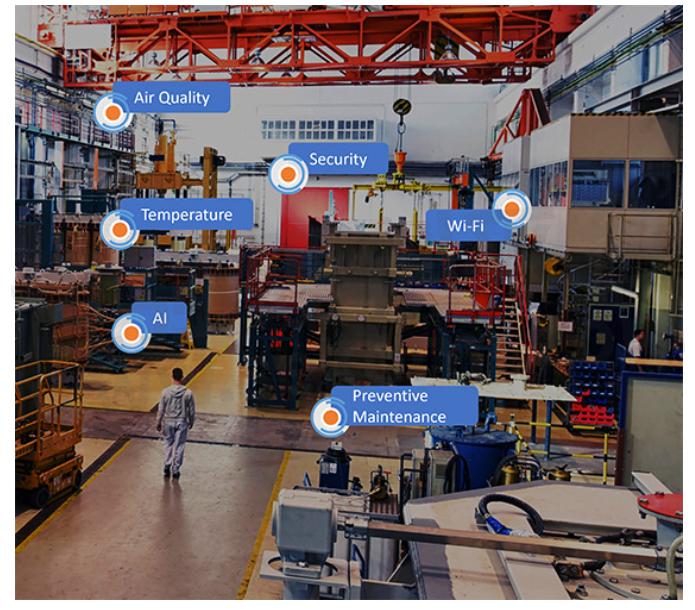Wireless Power: Revolutionizing The Manufacturing Sector

The global IoT in manufacturing market could reach $1.8 trillion by 2032, nearly ten times its 2022 valuation of $202 billion. As the warehousing sector deploys IoT devices on a massive scale to optimize production and decrease downtime, these devices must have reliable and consistent power. Historically, charging cables and disposable batteries have been used, but they can be costly to manage – especially in large-scale deployments – and they often end up as toxic waste in landfills. In North America alone, billions of batteries are thrown into landfills each year, potentially releasing life-threatening chemicals into the ecosystem.
Wireless charging offers a more stable, reliable, and effective method for powering IoT devices. Integrating wireless charging technology into IoT devices and deploying them in manufacturing provides key benefits, including the elimination of manually changing batteries and power cords for hundreds or even thousands of devices. Reduced downtime ultimately increases business productivity and efficiency. Below, we’ll look at the role of wireless charging in powering the expansion of IoT in global manufacturing.

Fig.1 Industrial deployment of wireless power.
Powering Productivity
Wireless power provides manufacturing sensors and monitoring devices with a consistent and uninterrupted power source. This consistency ensures the reliable operation of sensors needed for applications such as asset tracking, environmental controls, and electronic locks in the manufacturing sector. Unlike traditional power methods such as charging cords and batteries, which can cause production delays and financial losses if they fail, wireless power enhances real-time tracking of vital logistics data, such as asset movement and temperature controls.
Consider a pharmaceutical manufacturer responsible for producing and delivering medication for healthcare facilities. When the medication is ready to leave the warehouse, asset trackers are attached to each container to collect data on location, temperature, shocks or vibrations during transit, and much more. But those asset trackers only work if they’re powered and operating 100% of the time; if a battery dies or a cord is unplugged, that information is lost. This can have severe consequences if the medicine is damaged or rendered unusable during transit because it wasn’t tracked accurately from beginning to end.
Safer By Design
Electrical hazards are one of OSHA’s top safety concerns for manufacturing workers due to a lack of power cord durability that exposes facilities to electric shock, burns, fires, and other risks. From 2011 to 2022, there were more than 1,300 electrical-related workplace fatalities. Traditional power methods can increase the risk of accidents in the workplace, from trips over cluttered cords to wet cord connectors, and contribute to unsafe environmental exposure levels from toxic e-waste. The reliability of wireless power ensures that workers and critical goods maintain the specific environmental conditions, like temperature and humidity, needed to thrive.
Manufacturers can say goodbye to tangled wires and harmful batteries with wireless power systems. Wireless power receivers have a small footprint and don’t require direct connection to transmitters, which can be placed near or far depending on the circumstances. Furthermore, wireless power solutions ensure workers aren’t exposed to dangerous radiation by keeping specific absorption rates (SAR) – the rate at which the body absorbs energy from an electromagnetic field – within safe guidelines. Users can benefit from wireless power’s safety, convenience, and reliability while absorbing less radiation than a cellphone.
Tackling E-Waste
According to a survey conducted by the Manufacturing Leadership Council, 58% of respondents in 2022 believe that sustainability is essential to future competitiveness, up from 38% in 2021. The production of devices that rely on physical power methods consumes energy and generates waste–contributing to a growing global e-waste problem: the UN found that around 53.6 million metric tons are produced yearly. Addressing these challenges is essential for the manufacturing industry to transition towards a more sustainable future. Wireless charging can reduce emissions and material consumption, all while driving down production and maintenance costs.
Amid a years-long climate crisis created mainly by human action (and inaction), manufacturers have a role in reducing waste. Transporting goods releases billions of tons of CO2 and other damaging greenhouse gasses into the environment every year. Logistics service providers can use wireless power technology to optimize delivery routes and monitor inventory status with tracking systems that don’t require physical power sources. With 30,000 tons of batteries disposed of globally each year and only 3% recycled properly, wireless power can drive a more sustainable and efficient world.
Growing Wirelessly
Relying on outdated solutions to power critical monitoring capabilities, the manufacturing industry risks inhibiting the growth of IoT in industrial applications and stunting the ability of sensors to deliver on their promise. As companies rapidly adopt innovative technology that offers increased access to data about critical logistics and manufacturing processes, your business can’t be left behind. Embracing wireless power technology is vital to removing these constraints and fostering unrestricted growth and innovation in the sector.
- +1 Like
- Add to Favorites
Recommend
- Wi-Fi 6 Module 802.11ax: Shaping the Future of Wireless
- Bus Stop Buttons Are Now Wireless & Battery-Free Thanks to the Energy Harvesting Switch Technology from ZF
- Renesas Partners with Jariet Technologies to Bolster Wireless Transceiver Solutions Portfolio
- Renesas Expands Wireless Power Portfolio with 15W Wireless Power P9415-R Receiver Featuring WattShare TRx Mode
- Energous‘s 2w Powerbridge Transmitter Systems Delivers Continuous Access to Wireless Power, Enabling the Retailer to Optimize Grocery Distribution Network
- How to Cut the Cord and Save Energy with Sub-GHz Wireless Networks for HVAC Systems
- Nisshinbo and KIT Have Started the Development of Radio Frequency Rectifier IC Focused on Microwave Wireless Power Transfer Systems
- Industrial Wireless Router Powering Smart Water Automation and Wireless Monitoring Solutions
This document is provided by Sekorm Platform for VIP exclusive service. The copyright is owned by Sekorm. Without authorization, any medias, websites or individual are not allowed to reprint. When authorizing the reprint, the link of www.sekorm.com must be indicated.





























































































































































































































































































































































































































































































































































































































































































































































































































































































